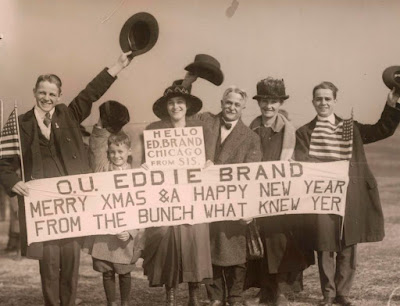 |
Film poster Under Four Flags (USA, 1918)Link to high res image |
"The Victory of Democracy"
With 1,820 bookings in American theaters, grossing almost $ 64,000,- Under Four Flags did not live up to the expectations of the CPI Film Division. The movie premiered in New York City at the prestigious Rialto and Rivoli theaters in November 1918, shortly after the Armistice was signed. The end of World War I was included into the movie with a caption announcing "The Victory of Democracy". President Woodrow Wilson next was shown on screen, as are victory parades in Washington, D.C. The film concluded: “And now the cannon’s roar has ceased and peaceful days and peaceful nights have come again to those across the seas." |
Scene from Under Four Flags, reproduced in an article published in Photoplay Magazine, January 1919 |
Public interest in the Great War quickly disappeared in the United States after the signing of the Armistice, which is - apart from the impact of the flu epidemic - the main reason why Under Four Flags did not prove to be a box office hit. As described by Benjamin B. Hampton in his book The History of the American Film Industry: "On November 11th war pictures were saleable merchandise; on the night of November 11th they became unmarketable. During the dull months of 1918, while the studios were marking time, the principal item of production had been war pictures. On Armistice Day, distributors and producers had almost nothing else in their warerooms; they faced the loss of millions of dollars in property now worthless through this sudden twist in the taste of their customers."
The original film version of Under Four Flags had seven reels, with footage showing the American offensives at Château-Thierry and St. Mihiel. As a contribution to the Allied war effort, the fifth reel had scenes showing the Italian army fighting against the Austrians in the Alps. Most of the original footage in this CPI movie was shot by military cameramen of the U.S. Signal Corps in France. The footage from the Library of Congress runs for about 25 minutes. Although it is not a complete print and despite the uneven pictorial quality the original intertitles which were written by Kenneth C. Beaton are still in place and give a good impression of this remarkable World War I propaganda film.
Although now considered "silent", this World War I film originally had a musical score which tied in with the Christmas season of 1918 and was composed by Hector Richard.
Here is a download link to the film music of Under Four Flags, also available at the Library of Congress.





